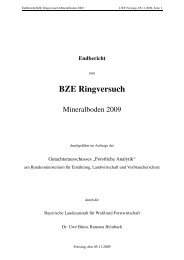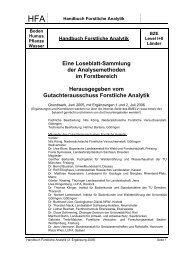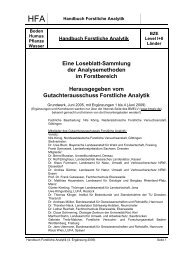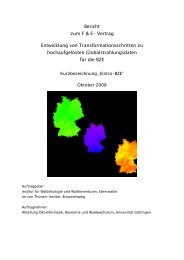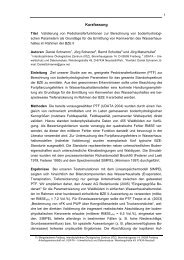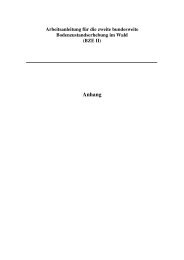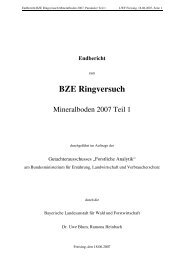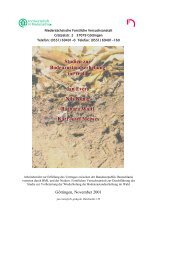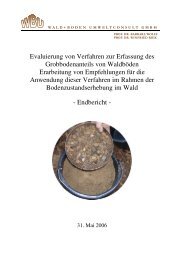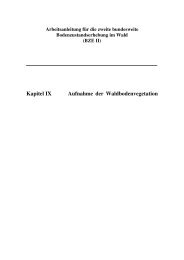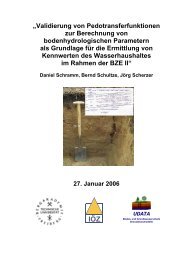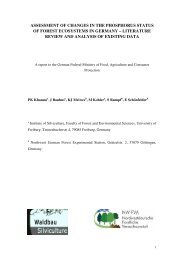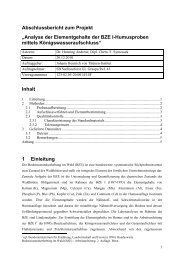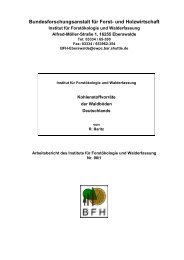assessment of changes in the phosphorus status of forest ...
assessment of changes in the phosphorus status of forest ...
assessment of changes in the phosphorus status of forest ...
You also want an ePaper? Increase the reach of your titles
YUMPU automatically turns print PDFs into web optimized ePapers that Google loves.
3.2.2 Inorganic forms <strong>of</strong> P - desorption and retention processes<br />
The forms and relative quantity <strong>of</strong> different P fractions <strong>in</strong> soils depend on a number <strong>of</strong><br />
soil properties (described above), environmental conditions and management factors<br />
(biomass removal, fertilization, litter <strong>in</strong>puts, fire). Three parameters are considered<br />
important <strong>in</strong> def<strong>in</strong><strong>in</strong>g <strong>the</strong> P availability <strong>in</strong> soils: a) <strong>the</strong> <strong>in</strong>tensity <strong>of</strong> P retention <strong>in</strong> <strong>the</strong><br />
solid phase (b<strong>in</strong>d<strong>in</strong>g with respect to desorption processes), b) <strong>the</strong> capacity or <strong>the</strong><br />
amount <strong>of</strong> P reta<strong>in</strong>ed (amount <strong>of</strong> P <strong>in</strong> <strong>the</strong> b<strong>in</strong>d<strong>in</strong>g forms which undergo desorption<br />
reactions, also described as labile P) and c) <strong>the</strong> k<strong>in</strong>etics <strong>of</strong> P release to soil solution.<br />
The <strong>in</strong>tensity parameter is described by <strong>the</strong> P concentration <strong>in</strong> <strong>the</strong> soil solution<br />
(discussed above). The soil property controll<strong>in</strong>g <strong>the</strong> relationship between <strong>the</strong> solid<br />
phase P and its concentration <strong>in</strong> solution is known as <strong>the</strong> buffer<strong>in</strong>g capacity. The solid<br />
phase P <strong>in</strong>volved <strong>in</strong> this relationship is only a small proportion <strong>of</strong> <strong>the</strong> total P, and is<br />
known as labile P. It is usually measured by isotopic exchange, but this exchangeable<br />
P component does not <strong>in</strong>clude <strong>the</strong> spar<strong>in</strong>gly soluble compounds that also get<br />
replenished by plant uptake. The buffer<strong>in</strong>g capacity is <strong>the</strong> ability <strong>of</strong> <strong>the</strong> soil solution to<br />
resist a change <strong>in</strong> its P concentration as P is removed by plant uptake, or is added <strong>in</strong><br />
<strong>the</strong> form <strong>of</strong> fertilisers or organic materials. Relationships between <strong>the</strong> concentration <strong>of</strong><br />
solution P and <strong>the</strong> amount <strong>of</strong> labile P (sorbed P) are experimentally obta<strong>in</strong>ed (also<br />
called sorption iso<strong>the</strong>rms), and by fitt<strong>in</strong>g a suitable equation, such as <strong>the</strong> Langmuir,<br />
<strong>the</strong> total sorption capacity as well as <strong>the</strong> sorption strength can be determ<strong>in</strong>ed.<br />
Buffer<strong>in</strong>g capacity determ<strong>in</strong>es <strong>the</strong> ease <strong>of</strong> desorption <strong>of</strong> labile solid phase P, its<br />
diffusion and thus its uptake. One very simple and widely used method to compare P<br />
sorption by different soils is to determ<strong>in</strong>e s<strong>in</strong>gle po<strong>in</strong>t adsorption and calculate an<br />
<strong>in</strong>dex as was suggested by Bach and William (1971).<br />
Follow<strong>in</strong>g from <strong>the</strong> above, available P is a direct function <strong>of</strong> <strong>the</strong> quantity <strong>of</strong> labile P<br />
and an <strong>in</strong>verse function <strong>of</strong> buffer<strong>in</strong>g capacity, and <strong>the</strong> most effective methods <strong>of</strong><br />
measur<strong>in</strong>g available P (soil tests) are those which remove a proportion <strong>of</strong> labile P that<br />
is <strong>in</strong>versely related to buffer capacity (Holford 1997). The quantity <strong>of</strong> labile P <strong>in</strong> a soil<br />
that is required to construct <strong>the</strong> sorption iso<strong>the</strong>rms is difficult to assess and many<br />
methods are used for that purpose. Among <strong>the</strong>se, <strong>the</strong> use <strong>of</strong> <strong>the</strong> isotopically<br />
exchangeable fraction, use <strong>of</strong> anion exchange res<strong>in</strong>s, or <strong>in</strong> recent years <strong>the</strong> use <strong>of</strong> Feimpregnated<br />
paper are common. Ulrich and Khanna (1968) <strong>in</strong>vestigated <strong>the</strong><br />
isotopically exchangeable fraction <strong>of</strong> a number <strong>of</strong> <strong>forest</strong> soils and reported <strong>the</strong><br />
follow<strong>in</strong>g general observation. When <strong>the</strong> amount <strong>of</strong> Al- and Fe-phosphates were low<br />
<strong>in</strong> soils, <strong>the</strong> fraction <strong>of</strong> <strong>the</strong>m occurr<strong>in</strong>g as isotopically exchangeable tended to be quite<br />
high (60-80% for Al-P, and 10-30% for Fe-P) <strong>in</strong>dicat<strong>in</strong>g a low degree <strong>of</strong> crystall<strong>in</strong>ity<br />
57



